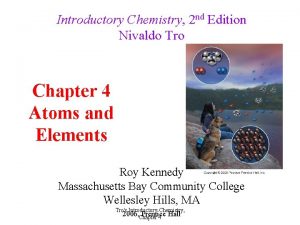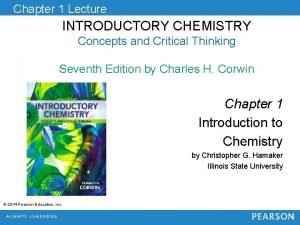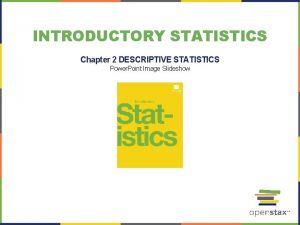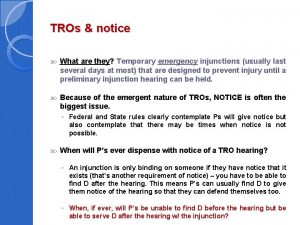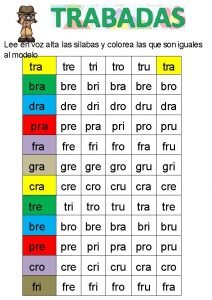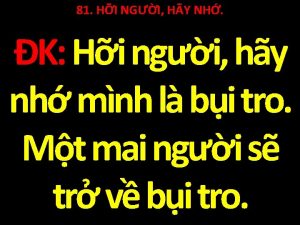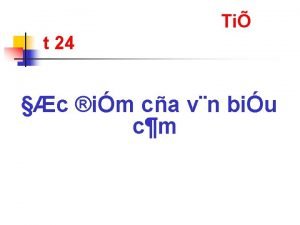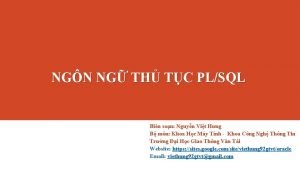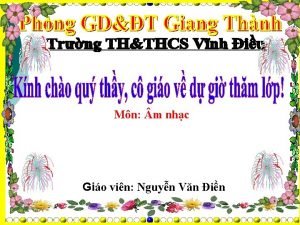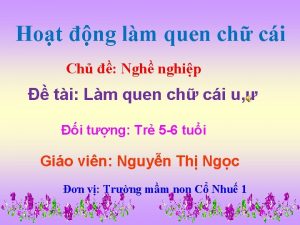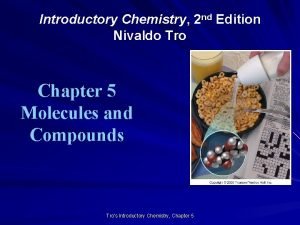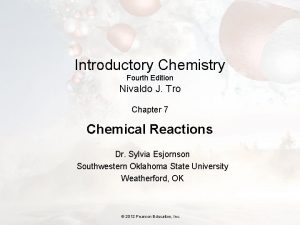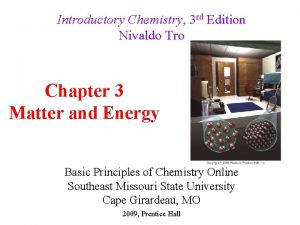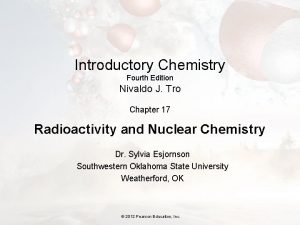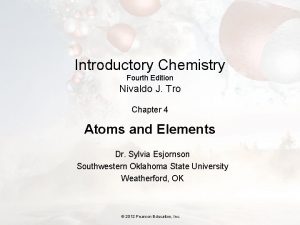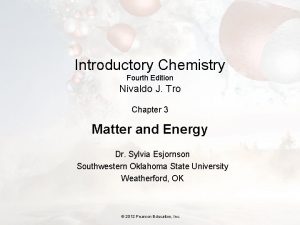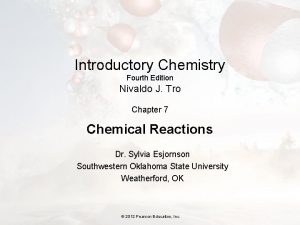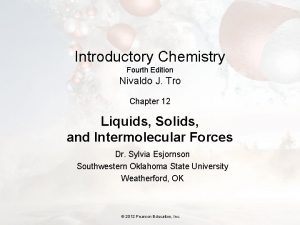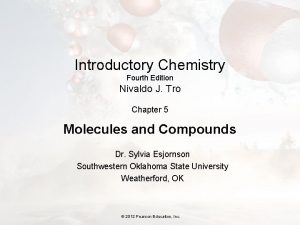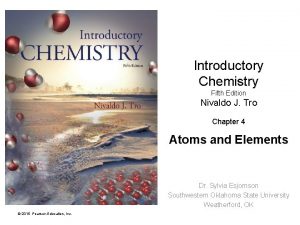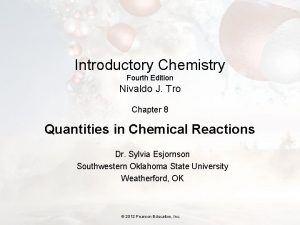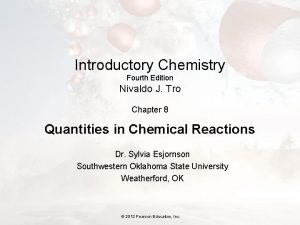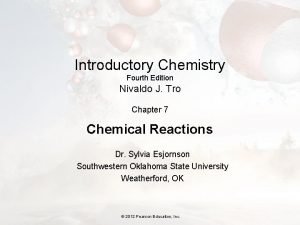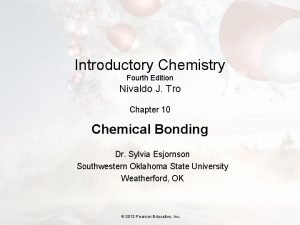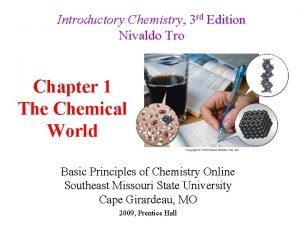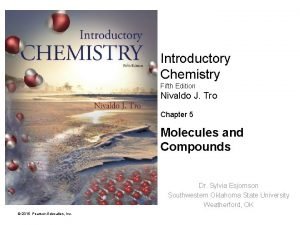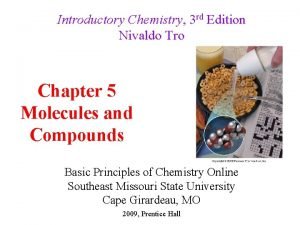Introductory Chemistry 2 nd Edition Nivaldo Tro Chapter



















- Slides: 19

Introductory Chemistry, 2 nd Edition Nivaldo Tro Chapter 4 Atoms and Elements Roy Kennedy Massachusetts Bay Community College Wellesley Hills, MA Tro's Introductory Chemistry, 2006, Chapter Prentice 4 Hall

4. 2 The Divisibility of Matter • Infinitely Divisible üfor any two points there is always a point between • Ultimate Particle üupon division eventually a particle is reached which can no longer be divided “Nothing exists except atoms and empty space; everything else is opinion. ” - Democritus 460– 370 B. C. Tro's Introductory Chemistry, Chapter 4 2

Dalton’s Atomic Theory 1. Elements are composed of atoms ü tiny, hard, unbreakable, spheres 2. All atoms of an element are identical 3. Atoms combine in simple, whole-number ratios to form molecules of compounds Ø Law of Constant Composition Ø Chemical Formulas Tro's Introductory Chemistry, Chapter 4 John Dalton (1766 -1844) 3

Dalton’s Atomic Theory 4. In chemical reactions, atoms are not broken or changed into another type. ü atoms are not created or destroyed, just rearranged – Law of Conservation of Mass Tro's Introductory Chemistry, Chapter 4 4

Sizes of Atoms • using compositions of compounds and assumed formulas, Dalton was able to determine the relative masses of the atoms üDalton based his scale on H = 1 amu üunit = atomic mass unit • absolute sizes of atoms ümass of H atom= 1. 67 x 10 -24 g üDiameter ~ 1 x 10 -10 m üvolume of H atom = 2. 1 x 10 -25 cm 3 Tro's Introductory Chemistry, Chapter 4 5

Modern Evidence for Atoms nanotechnology Tro's Introductory Chemistry, Chapter 4 6

4. 3 The nuclear atom • Work done by J. J. Thomson and others proved that the atom had pieces called electrons cathode ray tube • Thomson found that electrons are much smaller than atoms and carry a negative charge ü the mass of the electron is 1/1836 th the mass of a hydrogen atom ü the charge on the electron is the fundamental unit of charge which we will call – 1 charge units Tro's Introductory Chemistry, Chapter 4 7

Thomson’s Interpretation the Plum Pudding Model There must be a positive charge in the atom! Tro's Introductory Chemistry, Chapter 4 8

Some Notes on Charge Two Kinds of Charge called + and – • Opposite Charges Attract • Like Charges Repel • To be Neutral, something must have no charge or equal amounts of opposite charges Tro's Introductory Chemistry, Chapter 4 9

Plum Pudding Atom Tro's Introductory Chemistry, Chapter 4 10

Rutherford’s Experiment Alpha Particles Striking Screen Radioactive Sample Lead Box Gold Foil Tro's Introductory Chemistry, Chapter 4 Fluorescent Screen 11

Plum Pudding Atom • • • a few of the a particles do not go through • • • if atom was like a plum pudding, all the a particles should go straight through • • • Nuclear Atom . most a particles go straight through . . some a particles go through, but are deflected Tro's Introductory Chemistry, Chapter 4 12

Rutherford’s Results • Over 98% of the a particles went straight through • About 2% of the a particles went through but were deflected by large angles • About 0. 01% of the a particles bounced off the gold foil ü“. . . as if you fired a 15” canon shell at a piece of tissue paper and it came back and hit you. ” Rutherford exp Tro's Introductory Chemistry, Chapter 4 13

Rutherford’s Conclusions • Atom mostly empty space • Atom contains a dense particle that was small in volume compared to the atom but large in mass • This dense particle was positively charged Tro's Introductory Chemistry, Chapter 4 14

Rutherford’s Interpretation – the Nuclear Model 1) The atom contains a tiny dense center called the nucleus ü Nucleus = baseball; atom = 2. 5 mi, electron = period 2) The nucleus has essentially the entire mass of the atom 3) The nucleus is positively charged 4) The electrons move around in the empty space of the atom surrounding the nucleus 15

4. 4 Structure of the Atom • Rutherford proposed that the nucleus had a particle that had the same amount of charge as an electron but opposite sign a ”proton” • For the atom to be neutral there must be equal numbers of protons and electrons • The nucleus also contains neutrons…mass and proton repulsion. Tro's Introductory Chemistry, Chapter 4 16

Some Notes on Charge Two Kinds of Charge called + and – • Opposite Charges Attract • Like Charges Repel • To be Neutral, something must have no charge or equal amounts of opposite charges Tro's Introductory Chemistry, Chapter 4 17

The Modern Atom • Protons, neutrons and electrons • The nucleus – protons and neutrons • The electrons move outside the nucleus Tro's Introductory Chemistry, Chapter 4 18

Tro's Introductory Chemistry, Chapter 4 19
 Introductory chemistry 5th edition nivaldo j. tro
Introductory chemistry 5th edition nivaldo j. tro Introductory chemistry 5th edition nivaldo j. tro
Introductory chemistry 5th edition nivaldo j. tro Nivaldo j. tro introductory chemistry
Nivaldo j. tro introductory chemistry Introductory chemistry 4th edition
Introductory chemistry 4th edition Introductory chemistry concepts and critical thinking
Introductory chemistry concepts and critical thinking Pericyclic
Pericyclic Organic chemistry (3rd) edition chapter 1 problem 20s
Organic chemistry (3rd) edition chapter 1 problem 20s Halohydrin
Halohydrin Using mis 10th edition
Using mis 10th edition Mis
Mis Chapter 2 descriptive statistics answer key
Chapter 2 descriptive statistics answer key Notice tro
Notice tro Palabras con pra
Palabras con pra Bài 2 cải tạo tu bổ vườn tạp
Bài 2 cải tạo tu bổ vườn tạp Hỡi người hãy nhớ mình là bụi tro
Hỡi người hãy nhớ mình là bụi tro Các phương thức biểu đạ
Các phương thức biểu đạ Con trỏ sql
Con trỏ sql Trò chơi khuông nhạc bàn tay
Trò chơi khuông nhạc bàn tay Trò chơi xem kịch câm
Trò chơi xem kịch câm Trò chơi chữ cái u ư chủ đề nghề nghiệp
Trò chơi chữ cái u ư chủ đề nghề nghiệp


